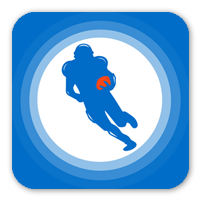Rick Lucks breaks down Statcast Pitch Tracking and platoon splits for individual pitch types as his series on making sabermetrics more accessible to fantasy baseball managers continues.
When you're evaluating a pitcher by Pitch Info on FanGraphs, sometimes you see pitches that don't seem to accomplish anything. If Pitch X is seldom a strike, rarely chased outside of the zone, and not generating whiffs or a favorable batted line against, why doesn't the pitcher scrap it entirely?
Some pitchers could improve by dramatically decreasing how often a particular pitch is thrown or even removing one from their arsenal, but the rate of this is much lower than you'd expect at first glance. The reason why is a key piece of baseball that Pitch Info doesn't get into: platoon splits.
Baseball Savant gives fantasy managers access to platoon splits by pitch type, allowing us to make an informed decision about whether a pitch mix change would truly prove advantageous. The best way to access this information is by typing in a pitcher's name in the search bar on the top-right corner of Baseball Savant and scrolling to the second table labeled "Pitch Tracking." Next, toggle "Handedness" to either righties or lefties and give it a few seconds to refresh. You're ready to rock!
Be sure to check all of our fantasy baseball lineup tools and resources:- Fantasy baseball trade analyzer
- BvP matchups data (Batter vs. Pitcher)
- PvB matchups data (Pitcher vs. Batter)
- Who should I start? Fantasy baseball comparisons
- Daily MLB starting lineups
- Fantasy baseball closer depth charts
- Fantasy Baseball live scoreboard
- Fantasy baseball injury reports
Interpreting Pitch Tracking Data
The Pitch Tracking table can be intimidating when you first look at it, so let's get that out of the way right now:
We start with the total number of pitches thrown, pitches thrown versus RHB and LHB, and pitch usage percentage. Adding pitch velocity, plate appearances, at-bats, hits, singles, doubles, triples, homers, and batted ball events (BBE) is probably unnecessary on this chart, but they are grouped so you can ignore them fairly easily. Similarly, average exit velocity and launch angle feel extra when the xStats are right there.
One of the biggest downsides of platoon splits for individual pitches is that you're almost always working with small sample sizes, meaning that fortunate bounces could skew the results. Luckily, the table's inclusion of xStats lets you know both how hitters fared against a particular pitch and how they should have fared. Whiff% is tempting, but remember that it isn't the same as the SwStr% from FanGraphs. Years are listed in reverse order, so the most recent is on top.
Let's consider Gerrit Cole as an example of these numbers in action. The veteran ace threw five different pitches in 2023: fastball (53%), slider (20.8%), curve (12.1%), change (7.1%), and cutter (7%). Per Pitch Info, Cole's entire repertoire generates whiffs at a 10% clip or better, except his curve (9.1%). Similarly, his fastball and cutter have high Zone% rates to help Cole get ahead in the count. His curve's 48.7% Zone% doesn't do that, nor does its 27.6% chase rate work as a put away pitch.
The lazy analyst might decide Cole is better off scraping his curve, but it serves a vital purpose. Cole threw it more often to LHB than RHB, and it limited lefties to a .226 xBA and .305 xSLG last season. In contrast, LHB smoked his change for a .290 xBA and .595 xSLG. His cutter was better with a .266 xBA and .320 xSLG, but Cole's curve is the best option of the three.
Cole's curve might not produce the strikeouts fantasy managers crave, but the rest of his repertoire generates plenty. If Cole expects a lefty to put the ball in play, his curve is worthwhile.
What's Below the Pitch Tracking Table?
There is a ton of information beneath the Pitch Tracking table, but most of it is available elsewhere or is of limited use in fantasy. You may have seen analysts citing Vertical and Horizontal Movement for individual pitch types, but that's too abstract for fantasy purposes. Furthermore, the graphic that compares pitch movement to a hypothetical "average" pitch draws from all offerings within two miles per hour and six inches of extension in either direction.
That's a problem because the net is too broad. Returning to Cole as an example, his slider is a high-spin breaking pitch intended to generate strikeouts, while his change is low-spin to play off of his heater. Cole gets nearly the same extension on all of his pitches, and they both averaged 89.1 mph on the radar gun last season, so they're compared to the same "average" pitch despite doing completely different things. That's insane!
The rest of the charts feel superfluous. Run Values by pitch type are way too abstract. The Spin Direction table includes active spin if you're looking at a specific pitcher instead of the leaderboard, but this author feels that it's easier to put it into context with the leaderboard. Plate Discipline metrics are available in cleaner forms elsewhere, and the Expected HR by Ballpark table was covered previously.
Shift statistics are no longer relevant, with "Shades" becoming the new term with the rule changes. Shifts still have a full table, though. Pitch Distribution is covered by the Pitch Tracking table. Generally speaking, fantasy managers have no reason to scroll below the Pitch Tracking table.
Parting Thoughts
Platoons matter in baseball, and Baseball Savant gives us the tools we need to identify which pitches are a given arm's preferred weapons to go after righties and lefties. As always, it is best to combine this information with other data sources to determine who you want to roster to dominate your fantasy leagues. Stay tuned for more on how advanced stats can help you in 2024.
Download Our Free News & Alerts Mobile App
Like what you see? Download our updated fantasy baseball app for iPhone and Android with 24x7 player news, injury alerts, sleepers, prospects & more. All free!







 RADIO
RADIO

























